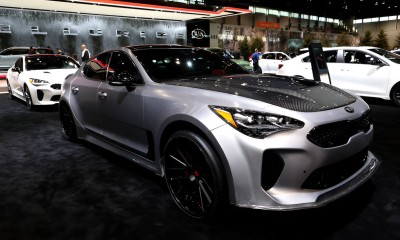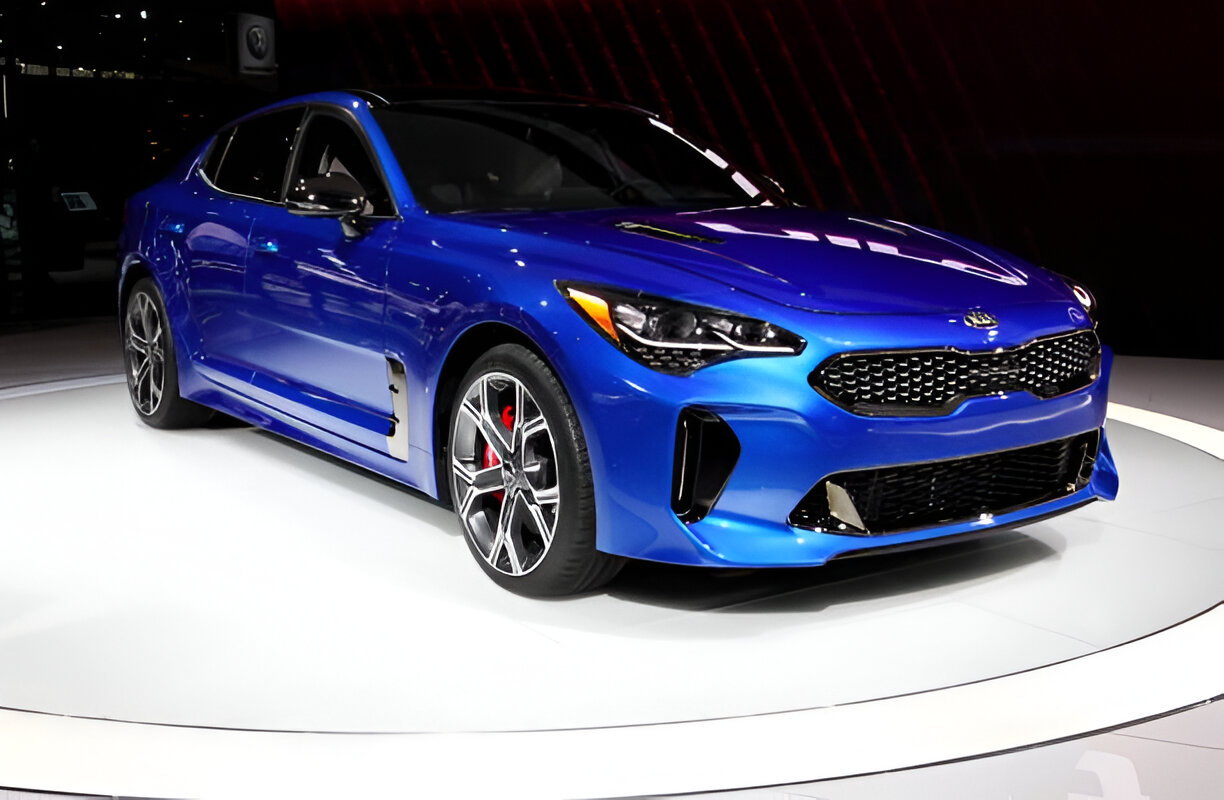The Final Sting: A Complete Guide to 2024 Kia Stinger Performance & Stage 2 Tuning

The automotive world is buzzing with inquiries about the "2024 Kia Stinger," and for good reason. However, it's crucial to begin with a point of clarification: the 2024 Kia Stinger is not a new generation but rather the exclusive, limited-run Tribute Edition. This special model serves as a final salute to a vehicle that fundamentally altered perceptions of the Kia brand, concluding a remarkable six-year production run. With only 1,000 units produced for the entire world—440 of which were allocated to the U.S. market—the Tribute Edition cements the Stinger's status as a rare and desirable modern classic.
The discontinuation of the Stinger is not an epilogue but the start of a new, exhilarating chapter written by the performance tuning community. When it launched for the 2018 model year, the Stinger was a "transformative moment for Kia," a bold statement of intent that proved the brand could compete with established European sports sedans. It successfully "put the brand on the map among enthusiast drivers," blending aggressive fastback styling, a luxurious interior, and potent turbocharged power into an accessible package.
While Kia's performance ethos now evolves with the all-electric EV6 GT, the Stinger remains the ultimate internal combustion canvas for tuners. Its robust engineering and proven powerplants provide a solid foundation for significant performance enhancement. This guide serves as the definitive resource for owners and professional tuning workshops, detailing the Stinger's factory capabilities and providing a clear, data-driven roadmap to unlocking its full potential through expert ECU and TCU tuning.
Deconstructing the Stinger's Performance DNA: Factory Specifications
To fully appreciate the impact of tuning, one must first understand the formidable baseline Kia engineered into the Stinger. The vehicle was offered with two primary engine choices, each providing a distinct level of performance that caters to different segments of the enthusiast market.
The 3.3L Twin-Turbo V6 (Lambda II T-GDi)
The heart of the Stinger's performance credibility lies in the Lambda II 3.3L twin-turbo V6, the standard engine for the GT, GT1, and GT2 trims, as well as the final Tribute Edition. This powerhouse established the Stinger as a true performance sedan.
-
Power and Torque: The engine produces a commanding 368 horsepower at 6,000 rpm and a massive 376 lb-ft of torque available from a low 1,300 rpm. This broad torque curve is responsible for the Stinger's effortless acceleration in any gear.
-
Acceleration: With this engine, the Stinger GT2 can sprint from 0-60 mph in a blistering 4.6 to 4.7 seconds, a figure that challenges many premium sports cars.
-
Top Speed: The rear-wheel-drive variants boast a manufacturer-claimed top speed of 167 mph (269 km/h), a testament to its grand touring capabilities.
The 2.5L Turbo I4 (Smartstream G2.5 T-GDi)
For the 2022 model year, Kia replaced the original 2.0L engine with the far more potent Smartstream 2.5L turbocharged four-cylinder in the GT-Line trim. This upgrade made the base model a serious performance car in its own right.
-
Power and Torque: This modern engine delivers an impressive 300 horsepower and 311 lb-ft of torque, placing it at the top of its class for standard four-cylinder sedans.
-
Acceleration: The GT-Line equipped with the 2.5T engine achieves a 0-60 mph time of approximately 5.3 seconds, offering a thrilling driving experience.
Shared Engineering Excellence
Beyond the engines, the Stinger platform is packed with high-performance components that create a cohesive and capable driving machine.
-
Transmission: Both engines are paired with a sophisticated 8-speed automatic transmission featuring paddle shifters for manual control.
-
Braking: High-performance models are equipped with powerful Brembo brakes, ensuring confident stopping power that matches the car's acceleration.
-
Drivetrain: The Stinger was engineered as a rear-wheel-drive (RWD) platform, appealing to driving purists. An advanced all-wheel-drive (AWD) system was also available, providing enhanced traction and all-weather capability.
The table below provides a direct comparison of the final production models.
|
Metric |
3.3L Twin-Turbo V6 (GT2 / Tribute) |
2.5L Turbo I4 (GT-Line) |
|
Engine Code |
Lambda II T-GDi |
Smartstream G2.5 T-GDi |
|
Displacement |
3342 cc |
2497 cc |
|
Horsepower |
368 hp @ 6000 rpm |
300 hp @ 5800 rpm |
|
Torque |
376 lb-ft @ 1300-4500 rpm |
311 lb-ft @ 1650-4000 rpm |
|
0-60 MPH (est.) |
4.7 seconds |
5.3 seconds |
|
Transmission |
8-Speed Automatic |
8-Speed Automatic |
|
Standard Drivetrain |
Rear-Wheel Drive (RWD) |
Rear-Wheel Drive (RWD) |
|
Available Brakes |
Brembo Performance Brakes |
Standard Disc Brakes |
The Digital Heartbeat: Understanding ECU and TCU Tuning
To unlock the Stinger's hidden performance, tuners must interface with its sophisticated electronic control systems. True optimization is a holistic process that addresses both the engine and the transmission, ensuring they work in perfect harmony.
What is ECU Tuning?
The Engine Control Unit (ECU) is the central computer responsible for managing every aspect of the engine's operation. It uses a series of complex software maps to control parameters like fuel injection, ignition timing, and turbocharger boost pressure. ECU remapping, or chiptuning, is the process of precisely modifying these maps to optimize performance.
The Kia Stinger 3.3T is equipped with a modern and capable Siemens SIM2K-260 engine controller, while other Kia/Hyundai applications often use Kefico or Bosch units. By recalibrating the software on these ECUs, tuners can safely increase power and torque by adjusting key parameters:
-
Boost Pressure: Increasing the pressure generated by the turbochargers forces more air into the engine, leading to a more powerful combustion event.
-
Ignition Timing: Advancing the timing of the spark plug firing can extract more energy from the air-fuel mixture.
-
Air-Fuel Ratio (AFR): Optimizing the ratio of air to fuel ensures efficient combustion and safe operating temperatures under higher load.
-
Torque Limiters: Factory software often includes artificial torque limits. Remapping can remove these to unleash the engine's full mechanical potential.
The Crucial Role of the Transmission Control Unit (TCU)
As engine output increases dramatically, the Transmission Control Unit (TCU) must be recalibrated to match. The TCU is the brain of the 8-speed automatic transmission, dictating how and when it shifts. A stock TCU is programmed to handle factory power levels. Subjecting it to an additional 80-100 lb-ft of torque from a tuned engine without recalibration can lead to sluggish shifts, premature wear, and an inability to effectively transfer the newfound power to the wheels.
A professional TCU tune is not just an add-on; it is an essential component of a comprehensive tuning package. The benefits are immediate and profound:
-
Faster Shift Speeds: Software optimization can significantly reduce the time it takes to change gears, minimizing the interruption of power delivery during acceleration.
-
Increased Line Pressure: The TCU tune increases the hydraulic pressure that clamps the transmission's clutches. This prevents clutch slippage under the immense torque of a tuned engine, ensuring a solid and direct transfer of power.
-
Optimized Shift Logic: The shift points and behavior in different driving modes (especially Sport mode) are made more aggressive and responsive, holding gears longer and downshifting more readily.
-
Enhanced Launch Control: The parameters for launch control can be adjusted, allowing for a higher launch RPM and more boost off the line for much more aggressive starts.
In essence, the ECU tune unlocks the power, and the TCU tune perfects its delivery. This synergy is the key to transforming the Stinger into a truly high-performance machine.
The Path to Power: Kia Stinger Tuning Stages Explained
Tuning is a progressive journey, typically categorized into "stages." Each stage represents a specific level of modification and a corresponding increase in performance. This provides a clear and structured upgrade path for owners and a straightforward service menu for professional workshops.
Stage 1 Tuning: The Foundation of Performance
A Stage 1 tune is the entry point into the world of performance enhancement and offers the best power-per-dollar upgrade available.
-
Definition: Stage 1 is a pure software optimization for a vehicle with completely stock hardware. No mechanical changes are required.
-
Process: The process involves connecting to the vehicle's OBD-II port, reading the original factory ECU file, and then writing a professionally modified file—like those available from the HP Chiptuningfiles database—back to the ECU.
-
Performance Gains (3.3T): Even without hardware changes, the results are dramatic. A quality Stage 1 remap can increase output by over 70 horsepower. For example, some tuners report gains of +71 hp and +44 lb-ft, elevating the 3.3T to approximately 436 hp and 420 lb-ft of torque. Piggyback tuners like the JB4, on a simple 93 octane map, have shown dyno results of around
-
386 wheel horsepower (whp) and 423 wheel torque (wtq), a substantial increase from the stock baseline of ~348 whp.
-
Benefits: The primary advantages are a significant boost in power and torque, sharper throttle response, and a more aggressive powerband, all achieved without the expense and labor of installing new parts.
Stage 2 Tuning: Unleashing the Beast
Stage 2 is where the Stinger's true potential is unlocked. It builds upon the software changes of Stage 1 with a suite of essential hardware upgrades designed to maximize engine efficiency and airflow.
-
Definition: A Stage 2 tune combines a more aggressive ECU calibration with supporting "bolt-on" modifications. The stock intake and exhaust systems, which are adequate for factory power, become significant restrictions at this level. Upgraded hardware is not just recommended; it is mandatory for the tune to function safely and effectively.
-
Mandatory Hardware Requirements (3.3T): To properly execute a Stage 2 tune on the 3.3L V6, the following components are required:
-
Upgraded Spark Plugs: Higher cylinder pressures and temperatures necessitate "one step colder" spark plugs to prevent knock (pre-detonation). HKS M45IL or Denso 5346 IKH24 are the industry standard for this application.
-
High-Flow Air Intakes: The V6 requires a dual intake system to allow the engine to inhale a much larger volume of air. Systems from brands like Injen, aFe POWER, and K&N are proven performers.
-
Performance Exhaust System: A full cat-back or turbo-back exhaust system with larger diameter piping (typically 2.5 inches or more) is needed to expel exhaust gases efficiently, reducing backpressure and allowing the turbos to spool faster.
-
Recommended - Intercooler Upgrade: While some tuners offer Stage 2 files without it, an upgraded intercooler is highly recommended. It drastically improves the cooling of the charged air from the turbos, preventing heat soak and ensuring consistent, repeatable power delivery, especially in warm climates or during track use.
-
-
Hardware Requirements (2.5T): The principles are the same for the four-cylinder model, scaled accordingly:
-
High-Flow Air Intake: A quality intake system can add up to +18 hp and +20 lb-ft of torque on its own before tuning.
-
Performance Downpipe/Exhaust: A less restrictive exhaust is crucial to let the engine exhale freely.
-
Upgraded Turbo (Optional): For those seeking power beyond a typical Stage 2, hybrid turbo upgrades are available that can push the 2.5T engine toward 450 hp.
-
The following table outlines the necessary hardware for a proper Stage 2 conversion.
|
Component |
Requirement for 3.3L Twin-Turbo V6 |
Requirement for 2.5L Turbo I4 |
Purpose / Benefit |
|
ECU Software |
Stage 2 Calibration File |
Stage 2 Calibration File |
Aggressively remapped for higher boost, optimized timing, and fueling to match hardware. |
|
Spark Plugs |
One Step Colder (e.g., HKS M45IL) |
One Step Colder (Recommended) |
Prevents detonation under higher cylinder pressures and heat. |
|
Air Intake System |
Dual High-Flow Cold Air Intakes |
Single High-Flow Cold Air Intake |
Increases airflow into the engine, allowing for more power generation. |
|
Exhaust System |
Full Cat-Back or Turbo-Back System |
Performance Downpipe & Cat-Back System |
Reduces exhaust backpressure, improving turbo efficiency and sound. |
|
Intercooler |
Upgraded, Larger Core (Recommended) |
Upgraded Core (Recommended) |
Cools charged air more effectively, preventing power loss from heat soak. |
The Proof is in the Power: Quantifying Stage 2 Performance Gains
Theoretical gains are one thing, but real-world, dyno-proven results are what truly matter to enthusiasts and professionals. The Kia Stinger, particularly the 3.3T model, has been extensively tested, and the data clearly demonstrates the transformative effect of a well-executed Stage 2 package.
3.3T V6 Dyno Results
The power progression from stock to Stage 2 is staggering. Using a Dynojet dynamometer, which is a common industry standard, we can see a clear path:
-
Stock Baseline: A healthy, stock Stinger GT typically measures around 348 wheel horsepower (whp) and 381 wheel torque (wtq).
-
Stage 1 / Simple Tune: A basic piggyback tuner (like a JB4 on Map 2 with 93 octane fuel) elevates this to approximately 386 whp and 423 wtq—a gain of nearly 40 whp and 42 wtq from software alone.
-
Full Stage 2: With the full suite of hardware and a dedicated Stage 2 ECU file, the numbers climb dramatically. Tuners consistently achieve and exceed 450 whp. Some packages are rated at the flywheel (crankshaft) at
-
449 hp and 435 lb-ft, which represents a massive gain of +84 hp and +59 lb-ft over the factory figures.
2.5T I4 Performance Potential
While the 2.5T is a newer platform with slightly less aftermarket data, the potential is clear. The engine starts at a robust 300 hp. Hardware upgrades alone, such as an intake, can add nearly 20 hp. Combined with a professional Stage 2 ECU remap, it is reasonable to expect power levels in the
350-370 hp range, turning the GT-Line into a formidable performance machine.
Real-World Impact
These numbers translate into a radical change in the driving experience. A Stage 2 Stinger is a completely different animal. The improved 0-60 mph times, drastically reduced quarter-mile times (tuned AWD models can dip into the high 10-second range), and ferocious in-gear acceleration transform the car from a quick grand tourer into a legitimate supercar competitor.
This table summarizes the performance journey for the flagship 3.3T model.
|
Performance Metric |
Stock Factory Rating |
Stage 1 Tune (Software Only) |
Stage 2 Tune (Software + Hardware) |
|
Estimated Flywheel Horsepower (HP) |
368 |
~436 |
~450+ |
|
Estimated Flywheel Torque (lb-ft) |
376 |
~420 |
~435+ |
|
Typical Wheel Horsepower (WHP) |
~348 |
~386 |
~420-450+ |
|
Typical Wheel Torque (WTQ) |
~382 |
~423 |
~450-500+ |
|
Typical Gain Over Stock (Flywheel) |
N/A |
+68 HP / +44 lb-ft |
+82 HP / +59 lb-ft |
The Professional's Edge: Why HP Chiptuningfiles is the Partner for Your Business
For professional tuning workshops, the Kia Stinger represents a significant and reliable business opportunity. Its popularity with enthusiasts and the proven reliability of its powertrain—the 3.3T engine is often described as "bulletproof"—mean there is a consistent demand for high-quality tuning solutions. Partnering with the right file provider is critical to capitalizing on this demand safely and profitably.
The HP Chiptuningfiles Advantage
HP Chiptuningfiles offers a comprehensive B2B solution designed to empower professional tuners and streamline their workflow.
-
Quality and Reliability: Our greatest asset is the quality of our files. Every Kia Stinger tuning file we provide has been meticulously developed and tested on our advanced 4x4 dynamometer. This ensures that the performance gains are not only impressive but also safe, reliable, and repeatable for your customers.
-
Comprehensive Support: We offer a full suite of solutions, from Stage 1 files for stock vehicles to aggressive Stage 2 calibrations for fully modified cars. We can also provide custom files for unique hardware combinations, ensuring you have the right software for any job.
-
Efficient Workflow: Our secure B2B portal is designed for speed and efficiency. Workshops can create a dealer account, purchase tuning credits at competitive prices, and download the exact files they need 24/7. This minimizes downtime and maximizes your workshop's throughput.
-
Hardware Solutions: We understand that a Stage 2 tune is a combination of software and hardware. We can assist in sourcing the necessary high-performance components, offering a more complete, one-stop solution for your customers' builds. Explore our hardware offerings to learn more.
Conclusion: Honoring a Legacy Through Performance
The Kia Stinger's production may have ended, but its story is far from over. It has transitioned from a bold challenger in the showroom to a celebrated icon on the tuning scene. Its legacy will be defined not by its final model year, but by the incredible performance that owners and tuners continue to unlock.
With a robust chassis and powerful, reliable engines, the Stinger is a platform begging to be modified. As we have demonstrated, a clear, data-backed path exists to elevate its performance to levels that rival, and often surpass, far more expensive machinery from premium German brands like(https://www.bmw.com/) or Audi. From a simple Stage 1 software flash to a full bolt-on Stage 2 transformation, the potential is immense.
HP Chiptuningfiles is proud to be at the forefront of this movement, providing the professionally engineered, dyno-tested software that serves as the foundation for these incredible builds. We are dedicated to helping both professional workshops and passionate enthusiasts write the next chapter in the Stinger's performance legacy.
Whether you are a tuning business ready to offer world-class Stinger solutions to your clients or an owner ready to experience your car's true potential, your journey starts here. Explore our chiptuning files or contact our expert support team to begin.
Frequently Asked Questions (FAQ)
Is the 2024 Kia Stinger a new model?
No, the 2024 Kia Stinger is not a new model year. It is the limited-production "Tribute Edition," which marks the end of the Stinger's production. It is based on the top-tier GT2 trim with the 3.3L twin-turbo V6 engine and features unique cosmetic enhancements.
How much horsepower can a Stage 2 tune add to a Kia Stinger 3.3T?
A professional Stage 2 tune, combined with required hardware like high-flow intakes, a full exhaust, and upgraded spark plugs, can add over 80 horsepower. This takes the stock 368 hp engine to approximately 450 hp or more, with wheel horsepower figures often exceeding 420-450 whp depending on the dyno and conditions.
Is tuning a Kia Stinger reliable?
Yes, when done professionally using high-quality components. The Stinger's 3.3L twin-turbo V6 engine is widely regarded as very robust and can reliably handle the increased power from Stage 1 and Stage 2 tunes. Using professionally developed, dyno-tested tuning files and the correct supporting hardware is essential for long-term reliability.
Will ECU tuning void my Kia Stinger's warranty?
Modifying your vehicle's ECU can potentially give the manufacturer grounds to deny a warranty claim on powertrain components. While some dealerships may be tuner-friendly, it is a risk that owners must be aware of. The manufacturer must prove that the modification directly caused the failure, but this can often lead to disputes. Many enthusiasts choose to tune their vehicles after the factory warranty period has expired.
Other news and updates

Read more OBD Breakthrough: Tuning Support for the Continental ASG1 ECU in Audi e-tron & Porsche Taycan
The Continental ASG1 ECU used in the Audi e-tron and Porsche Taycan is now fully supported for OBD read/write. This breakthrough allows safe tuning of torque limits, current maps, thermal strategies and pedal response, enabling measurable performance gains whi...
Read more

Read more Stage 1, Stage 2, and Stage 3 Tuning: Which One Is Right for You? | HP Chiptuning Files Europe & UK
Discover the differences between Stage 1, Stage 2, and Stage 3 tuning. Learn which remap is best for your car, driving style, and budget at hp-chiptuningfiles.com.
Read more

Read more Mercedes-AMG G63 2025: ECU Remap & Performance Boost
Hey, we are HP Chiptuningfiles – Europe’s leading ECU tuning file service provider. We deliver custom, dyno-tested tuning files for diesel, petrol & hybrid engines, trusted by 4,000+ clients worldwide. The 2025 Mercedes-AMG G63 combines iconic G-Class ruggedne...
Read more